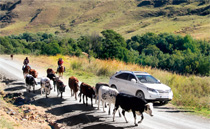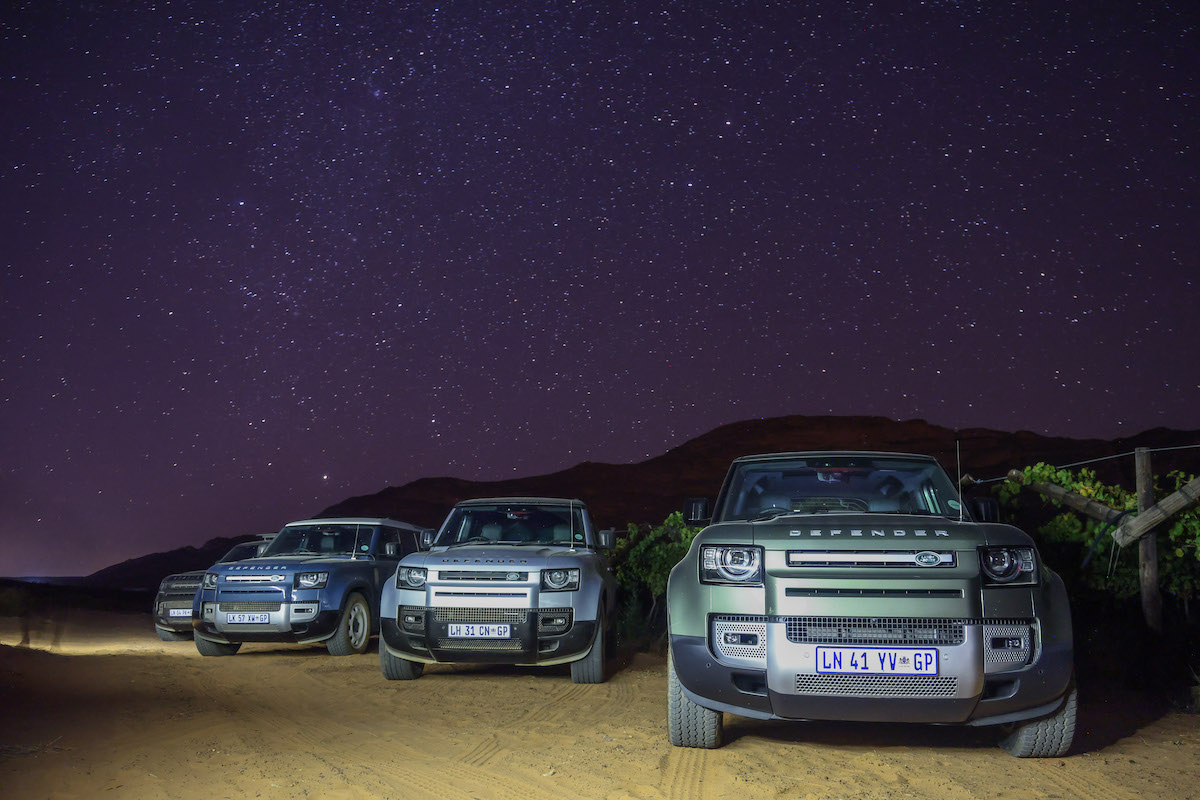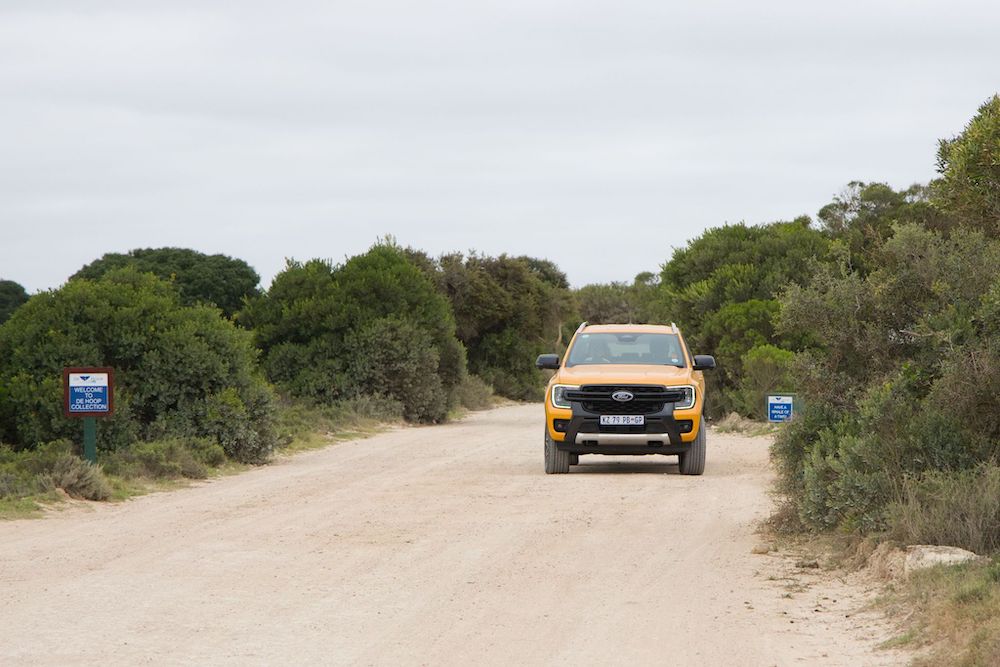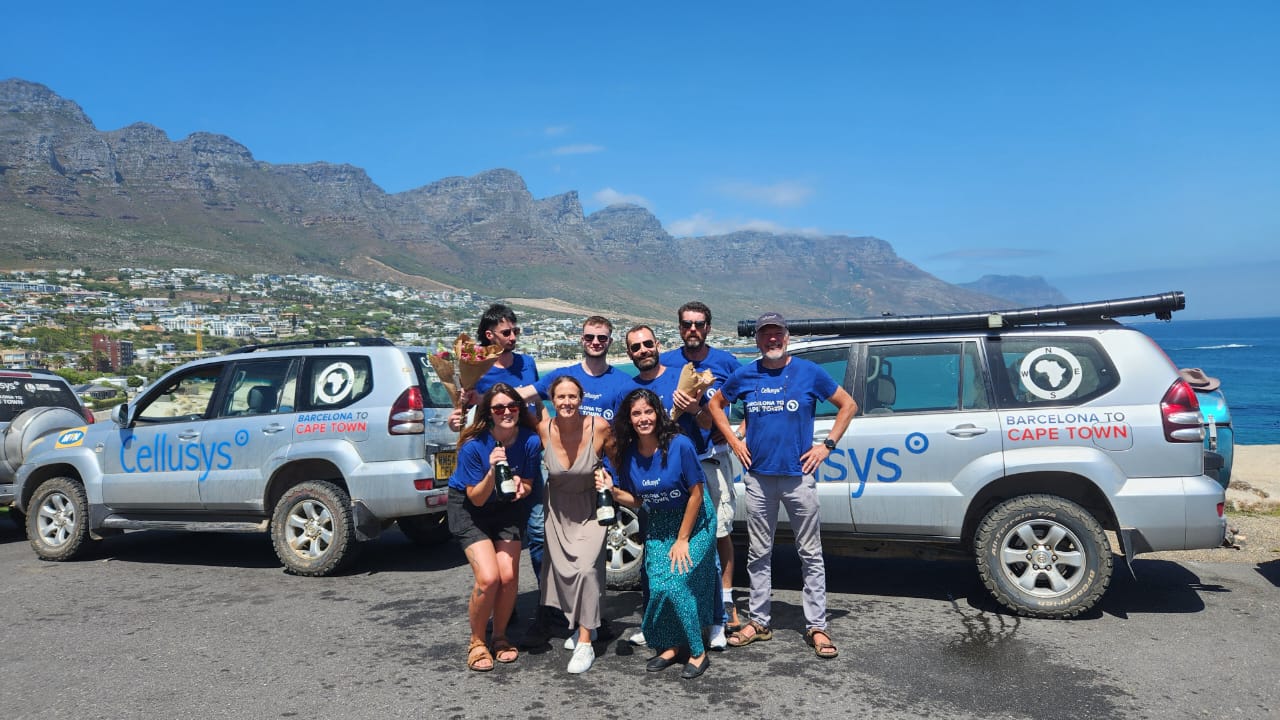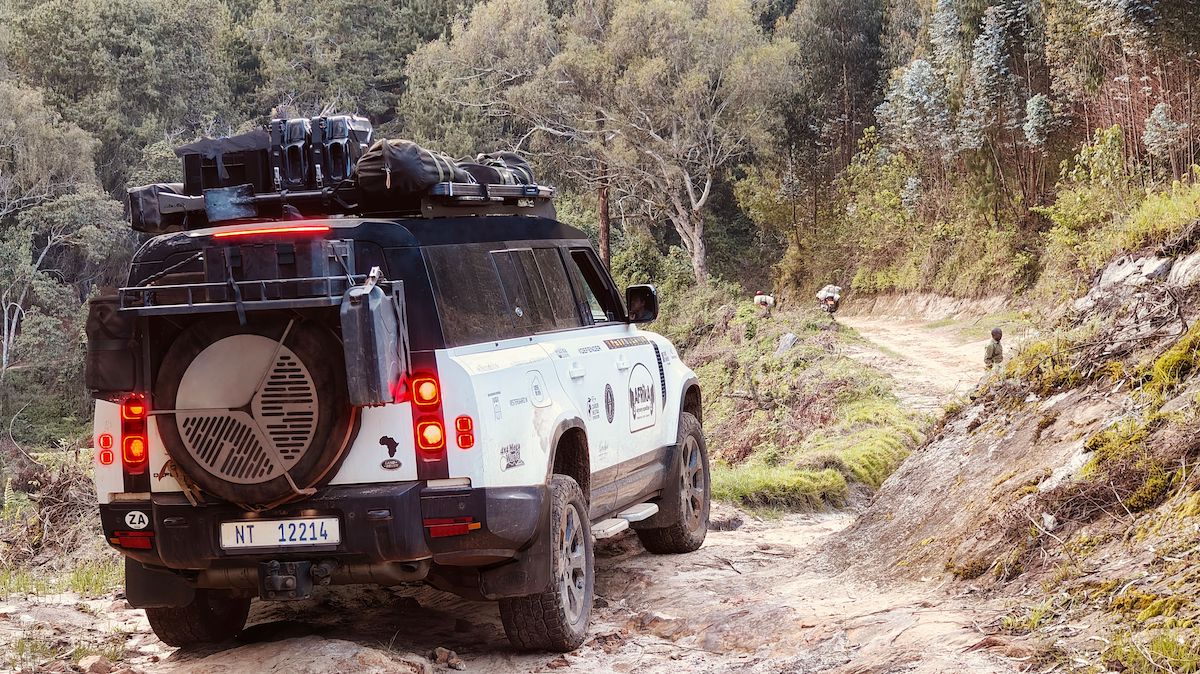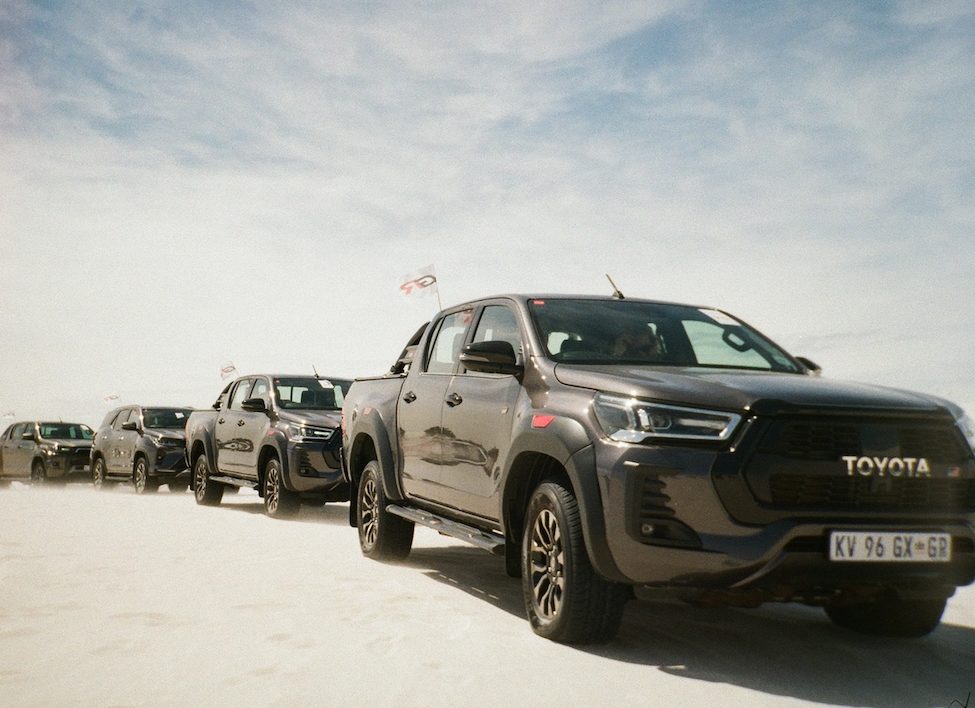Text: Danie Botha
Photography: Jannie Herbst
It is quiet. Dead quiet. Yet we are slowly crawling forwards and upwards, over rocks and through ruts and holes.
We have just completed the formalities at the South African border post. Now we are in no man’s land, between SA and Lesotho. We are on the famous – and sometimes infamous – Sani Pass.
We are driving a hybrid-powered 4×4 up the pass – the pass that has claimed numerous lives since the first vehicle scaled it in 1948, yet presents stunning views of the Drakensberg mountain range and the Underberg basin, far below.
We approach a river crossing lined with rocks. The water is not a problem, since the level is low. The rocks may be, as this 4×4 has only 175mm in ground clearance.
The Lexus RX450h designers and engineers probably didn’t have this kind of terrain and challenge in mind when they built this hybrid-powered SUV — more likely the muddy parking area next the school playing field. Or the pavement at the local shopping centre.
But here we are, on Sani Pass with its rocks, ice, rutted surface, massive drop-offs and steep and slippery gradients. In an SUV designed for a spot of mud, pavements, and wet dirt or tar roads.
Okay, so it had seemed a great idea at the time – drive the first hybrid vehicle up the pass! Whoa!
Now, as we silently approach the river crossing with only the main electric motor providing propulsion, we are not so sure about our judgment in undertaking this venture. How far will the RX be able to go up the pass before it suffers a mortal injury to its highly sophisticated electric/petrol drive train? Or worse, what if it goes over the? no wait, let’s not go there.
Instead, we decide that now is as good a time as any for that coffee break, to contemplate the task ahead of us. With some Java in hand, parked next to the track near the river crossing, I page through Michael Clark’s book titled The Saga of Sani Pass and Mokhotlong, and find a poignant paragraph to lift our spirits. And share it with my travelling companions.
“In 1960 a newly qualified driver, working for the Mokhotlong Mountain Transport company, was transporting a load of passengers down the pass at night – which was not allowed. The vehicle’s clutch started acting up, but he made it quite a way down the pass before arriving at one very tight corner that he just couldn’t negotiate. Instead of asking a passenger to place a rock behind a wheel while he kept the brakes applied, and then to inspect the corner, the driver jumped out, leaving the engine running with only the parking brake activated. Before he could place a rock in front of a wheel the vehicle went over the edge. Two of the 10 passengers were killed.”
With the coffee break over, we survey the river crossing, and plan a route. Behind the steering wheel, I press the “start” button. After driving the RX from Randburg to this particular spot, I now know what to expect to hear when I press that start button: Nothing. Ziltz. B?ggerol.
Instead, a green “Ready” light appears in the instrument panel, and the “power meter” – this Lexus doesn’t have a rev counter – moves to the “on” position.
Let go of the brake pedal and apply light pressure to the accelerator pedal and off it goes, without a sound. As soon as significantly more propulsion is required, the 183 kW V6 engine starts by itself, and also comes to the propulsion party. All the driver needs to do is modulate the accelerator pedal, and the electronics will sort out the details of how many kilowatts and how many watts need to go where and when.
I steer around and between and (occasionally over) those rocks in the water, and the Lexus quietly makes it through.
We slowly continue to climb, mostly with the V6 engine remaining mum. This is still the easy part of Sani – the really tough, slippery and steep sections are near the summit.
The bigger, centrally mounted motor delivers 123 kW of power and 335 Nm of torque (from zero revs) and this electric motor does most of the work during normal driving situations.
At slow speeds it provides the sole propulsion, but at higher speeds, when the V6 engine also gets into the act, it combines with the combustion engine to provide V8 levels of performance.
The second electric motor has 50 kW and 139 Nm, and it is active in only three situations. When the driver floors the accelerator pedal it provides additional thrust, helping the heavy Lexus to sprint from 0-100km/h in less than eight seconds. Secondly, when the front wheels lose traction it activates and sends its power to the rear wheels – turning the Lexus into a 4×4.
And lastly, on a long downhill, when the driver lifts his foot off the accelerator, the electric motor regenerates energy, and sends this energy to the battery (a 37 kWh nickel-metal hydride unit).
This Lexus doesn’t have low-range, differential locks and other 4×4 tricks. The power from the three powerplants is regulated by a state-of-the-art planetry gearset transmission with Artificial Intelligence AI-SHIFT – the latter technology a first for hybrid vehicles.
In the AI-SHIFT system, the electronics determine whether the Lexus is travelling uphill or downhill by comparing vehicle speed with the accelerator pedal angle. The transmission then selects the appropriate shift range to maintain engine revolutions at an optimum level for either uphill acceleration or downhill engine braking.
The system also features a “sport” mode with sequential shift-matic control – essentially six different steps, or speeds. This fits in with the RX450h’s role as a PerformanceHybrid – but we’re not sure how many users will ever use it. The system is so good in the default “Drive” setting that manually changing gears seems like a superfluous exercise.
The next obstacle is ahead. It’s a heavily rutted climb, with loose rocks strewn all over the road. Good thing that there is a viewpoint just before this section – the perfect opportunity to munch the chocolate brownies we’d bought in Underberg the previous day. Sensing the need for some more spirit lifting, I again turn to Michael Clark’s book for inspiration, and share it with my fellow adventurers.
“A Bedford truck stopped on a gentle slope because the driver needed to answer the call of nature. He left the engine running and engaged the handbrake. While he was answering the call of nature, the vehicle began to move. Two women were catching a lift on top of the load on the bak, and when the vehicle started rolling backwards, both jumped off. Unfortunately one woman jumped off at the rear of the truck, and the vehicle ran over her on its way to crashing down the mountain slope. She was killed, and the truck completely destroyed.”
The chocolate brownies are finished, and it’s time to tackle our first steep and slippery climb. It’s a little dress rehearsal for what’s to follow, if you like.
Mindful of the relatively low clearance, the low-profile 19-inch tyres and the fact that this hybrid retails for nearly R800 000, we tackle the climb at a snail’s pace. But that doesn’t work so well. The advanced gearbox, even with first gear manually selected, is not happy, and the Lexus grinds to an unimpressed halt, without even a hint of wheel spin.
A different approach is needed. Like a more speedy one. We reverse the RX down the steep embankment, with a heavy foot on the brake pedal. Then we charge the gradient with more vigour? and up she goes.
We continue the climb, unabated.
We arrive at the steepest section of the pass – the most difficult part that climbs about 250m towards the top of the pass, some 1,2km away. Tight switchbacks abound, with steep and slippery turns to negotiate.
The initial few hundred metres pose no problem, as by now we’ve worked out the ideal balance between momentum and grip. We arrive at Waterfall Corner, with about 200m left to climb.
It’s a spectacular corner. There’s a frozen waterfall on the outside of the corner, stunning vistas and large boulders, along with a glimpse of the last few switchbacks that will take us to the top of the pass.
This is it.
A Nissan Patrol, carting a bevy of wide-eyed international tourists up the pass, arrives on the scene. We let it go past on the narrow track. After three attempts to negotiate this slippery, steep and rutted corner, partly covered in ice, the Patrol makes it up. If a Nissan Patrol needs three attempts? well.
This corner needs something more than just momentum. So we disable the traction control system. After selecting a route over the ice and through the rocks and ruts, and with a generous helping of right foot, we go for it.
The wheels spin, but the Lexus keeps climbing. With the traction control on the reserves’ bench, the V6 engine seems much happier and more eager to rev – which is a very good thing for maintaining momentum here.
We make it, at the first go!
Oh dear. The next corner is already upon us. On this slippery surface and steep gradient, there’s no stopping now. We keep going at the best possible speed, mindful of the rocks, the ruts and the 19-inch wheels and limited clearance.
In places the wheels spin up a storm. But the tyres mostly find good purchase.
Finally, we see it? the top of the pass, and the Lesotho border post.
We’ve made it!
Whoa!
What goes up?
It’s soon time to head down the pass. And as most Sani regulars will confirm, the descent can be far more dangerous than the ascent. A pukka 4×4 with low-range transfer case is ideal here. Select low-range, and use first or second gears and the 4×4’s engine braking to ease your way down the steep and slippery sections. Easy.
We don’t have low-range. We don’t have massive amounts of ground clearance. We don’t have engine braking, since the V6 engine doesn’t activate when there is no throttle input (and there is none when you crawl down this steep pass). The braking system is a non-traditional one – the electro-hydraulic system features regenerative technology that charges the battery against compression, and when the brakes are activated.
So, in essence, we are about to help save the planet by emitting zero emissions – but will the fancy braking system keep us from testing out the RX’s ten airbags?
Before we head down the pass, it’s time for more enlightenment, courtesy of Michael Clark.
“A most spectacular event occurred in 1979 when a Toyota Land Cruiser was coming down the pass with three men in the cab. Nearing the end of the pass, a front wheel suddenly departed from the axle and they shot off the road, turning over, landing the Cruiser on its nose only 1,2m from the very edge of a drop-off that would have taken them down to the river, about 250m below. All three occupants escaped unharmed. When the driver was later asked what went wrong, he replied: “I do not really know, my head has not been working well since it happened.” Certainly they must have had a most monumental fright.”
We start down the pass. With first gear manually selected for good luck (but ineffectual, since the Lexus was operating only on electrical power), and with a heavy foot on the brake pedal, the initial going is, well, rather interesting.
The electro-hydraulic braking system, lacking a traditional vacuum servo and brake booster set-up and instead relying on electronic sensors, actuators and drive-by-wire technology (so there are no cables and linkages), requires some intricate modulation methods on terrain such as this.
In the first few corners – the very steep ones – the Lexus lurches forward briefly, then corrects itself, then briefly lurches forward again as the computer attempts to figure out what the blazes the driver is up to.
However, by corner six we’ve adapted our driving style to the braking system’s idiosyncrasies (applying slightly less pressure on the brake pedal puts the electronics more at ease) and our progress is much smoother.
And remember, we are saving the planet, with absolutely zero emissions.
We steadily make our way through the worst sections, including Waterfall Corner.
Not far from the corner we come across two hikers – we had passed them earlier, heading up the mountain.
We stop next to them, silently. The young German lady is looking decidedly tired, and her Romanian friend is not exactly perky.
“Are you okay, or can we give you a lift?” we ask.
“Zee lift will be good, ja. Danke,” she replies, her face sporting a red tint from the African sun. With our two passengers relaxing in the comfortable rear seats, we continue to the SA border post. The V6 engine is still taking a break.
It’s clear the Romanian fellow knows about cars.
“Zis is de hybrieed Lexus, yes?” he asks with his French/Romanian accent.
We confirm this fact, pointing out the energy information monitor in the centre console.
“Zis must be ze most, er, expenseeve car to go up ze mountain, no?”
“It probably is one of the most expensive. And as far as we know, it’s the first hybrid to scale this pass,” we reply, dodging another deep rut.
“Dis is good. Saving ze planet and driving ze four-wheel drive. Dis is very good,” says his German friend.
We reach the border post without further incident or book readings, and bid the two young tourists farewell. They jump into their little Chevrolet Spark, and head off onto the dirt road – which is not in the greatest of shape. Yup, that old saying rings true: The best 4×4 in the world is a rental car.
Later, on our way back to Randburg, we ponder the meaning of Lexus’ RX450h hybrid.
Will it single-handedly save the whales, the trees, the ozone layer and everything else that needs saving from an environmental point of view? No. But it least it does something about it.
Is it a highly capable 4×4 that will take you anywhere you want to go? No.
Does this vehicle represent the 4×4 of the future? Probably not, no.
However, what it does represent is an amazing technological achievement in marrying traditional and future propulsion methods in a most impressive manner to create an exclusive PerformanceHybrid 4×4. One that can do 200km/h and accelerate from 0-100km/h in 7,8 seconds, yet still produce the same emissions as a four-cylinder passenger car. That suggests supreme quality, exclusivity, refinement and class.
Very few RX450h owners will contemplate driving their R800 000 Lexus up Sani Pass. But what this adventure showed was that, contrary to what most people would think, it can actually do it. It is not just a finicky thing of technological wonder and fashion that is restricted to tar and cities. It loves dirt roads, and it’s not scared of a few ruts and rocks and steep and slippery climbs, either. There is much more to this Lexus than meets the eye.
And we believe it is the first hybrid-powered vehicle to have scaled the famous – and sometimes infamous – Sani Pass.
A performance hybrid? What the…?
Performance and ozone layer-saving technology are not normally mentioned in the same context. But with this Lexus it is.
Powered by a specially-adapted V6 petrol engine and two powerful electric motors, the RX450h, boasting a combined output of 220 kW of power, can run with a V8 petrol-powered SUV – but emits the same levels of carbon dioxide as a four-cylinder sedan. And that’s the secret of this hybrid – performance, but performance at a reasonable emission and consumption price.
Lexus Hybrid Drive is a combined series/parallel full hybrid system that comprises a very efficient petrol engine and two powerful electric motors.
As a full hybrid, the vehicle can operate on its electric motors or petrol engine alone, or with a combination of both. As with its predecessor, the new model’s second, rear-mounted electric motor provides an intelligent four-wheel drive capability.
The system combines distinct front and rear driving units, with a power control unit managing their seamless, high-speed interaction.
The 3,5-litre DOHC petrol engine is based on that used in the RX350, but has been adapted specifically for use in the hybrid powertrain. It produces a maximum 183 kW at 6000r/min and 317 Nm of torque at 4800r/min and features three Lexus hybrid “firsts” to optimise fuel efficiency — Atkinson cycle combustion, cooled exhaust gas recirculation (EGR) and exhaust heat recovery (EHR).
In an Atkinson cycle engine the valves close late, delaying compression. This creates a high expansion ratio for less compression, reducing intake and exhaust energy losses and converting combustion energy into engine power more effectively. As a result, the exhaust temperature is lower than in conventional engines.
EGR reintroduces cooled exhaust gas into the combustion chamber, further reducing the engine’s operating temperatures. Together these technologies minimise the need for any fuel enrichment to provide a cooling effect and protect the catalytic converter from overheating damage, thereby improving fuel economy and reducing emissions.
The EHR system uses exhaust gas heat to warm the engine coolant at start-up. This reduces the time the engine needs to warm up, allowing it to be shut off earlier for longer electric motor-only operation, particularly in winter.
Combined with the latest-generation planetry gearset transmission with advanced new features, the power from the three powerplants is transferred only to the front wheels, or to all four wheels (when the front wheels lose traction or during full throttle acceleration runs).
However, the “performance” of this Lexus is about more than just kilowatts and Watts. It is also about the way it handles and feels. The all-independent suspension set-up has been tuned with performance in mind.
Ditto the electric power steering system.
Chase the Lexus into a corner, and it will stick tenaciously to the chosen line, with very little body roll. It feels sporty. It feels “performance”.
Additionally, the Lexus is about sumptuous luxury. Standard features (on the top LXE model) include: Reverse camera, automatic climate control, remote touch for the latest in satellite navigation, on-board computer, climate control and audio system that is linked to an Electro Multi-Vision (EMV) display in the centre console, a voice command system (that can be quite entertaining to use!), heated and cooled front seats, a 15-speaker Mark Levinson surround sound system with iPod connectivity and a HDD system that can store up to 2000 songs, adaptive front lighting system (AFS) that swivels the headlights (projector-beam high intensity discharge units) – to name but a few of the highlights.
So yes, it is performance. It is hybrid. But it is also a performance hybrid with all the luxury and class in the world.
Sani – to the Roof, and beyond
Late in the 1800s the first settlers arrived in the Underberg district.
Doubtless they would have been impressed by the first glimpse of the Drakensberg mountain range, with its snow-covered peaks. They would have seen the two peaks that would later become known as Hodgson’s Peaks, and the natural indentation in the rock formations that would later be named Giant’s Cup.
Most importantly, to the north of the Hodgson’s Peaks area, they would have seen what looked like an easily traversable “pass” through the mountains. This would eventually become the Sani Pass.
However, in those days the region was still in a state of transition as the Bushmen (the original Drakensberg inhabitants) had fled the violence of the Zulu leader Shaka. The European settlers (mostly from Scotland) fought, negotiated, traded, fought, traded and negotiated their way to various resolutions with the local communities.
At that time the pass was used for trade between Chief Rafolatsanes (leader of the mountain people later known as the Basotho), the settlers and other parties. But the pass was the reserve of donkeys, horses and traders walking on foot. It was simply a bridle pass, and a rough one at that, with snow, ice and extreme cold making it an even more arduous journey.
It was only in 1948 that Godfrey Edmonds, a former Royal Air Force fighter pilot in the Second World, heard about Sani Pass after a chance meeting with the district commissioner of Mokhotlong – the town near Sani Pass that was the hub for trade with Natal.
Edmonds was selling the then brand new Willys Jeep in Kokstad, and suggested that this vehicle might offer a transport solution for growing trade relations in the region.
And so, in May 1948, Edmonds tackled Sani Pass, with a small trailer in tow. Edmonds, the Jeep and the trailer eventually made it to Mokhotlong, but it took the party 14 hours to cover 80km, with much hardship along the way. At times the Jeep had to be picked up and literally bounced around a corner – that’s how narrow it was in places. And don’t forget the terrifying drop-offs.
But Sani Pass had been conquered by an automobile.
In the years that followed, with news of this “adventure drive” spreading fast, more adventurers attempted the feat. Jeeps, Land Rovers, a Volkswagen Beetle (that was mostly carried up the mountain!), a Hillman Minx, a Morris Minor, caravans, Fords and Mercedes-Benz vehicles made it to the top.
With trade still the principal reason for the pass’s existence, transport companies continued to use it. In time the track was upgraded, and today, even though the steep gradients remain, the surface is much less daunting than in 1948.
Still, a 4×4 vehicle is required to enter the pass from the SA side – two-wheel drive vehicles are not allowed. And for good reason, too. Over the years many people have died, and lots of vehicles have been lost on Sani.
Sani’s ups and downs
Michael Clark arrived at the Sani Pass in 1959, working in the transport business, running people and cargo to and from Mokotlong, in Lesotho. The 79 year-old Clark is now retired but runs the beautiful Himeville
Museum. He has been involved with the Sani Pass for more than 40 years, and his book, The Saga of the Sani Pass and Mokhotlong, is as authoritative an account on the subject as you could find.
The book is a must-read for anyone interested in this famous pass. Besides the interesting historical highlights in the publication, he writes about the people who have been involved with the pass over the years, as well as all the cars and incidents.
The book retails for R125.
More information: Himeville Museum, Tel. 033 702-1184.
Lexus RX450h LXE – Specifications
Engine: 3,5-litre V6 petrol (183 kW and 317 Nm)
Electric motors: 123 kW/335 Nm and 50 kW/139 Nm
Battery: 37 kWh nickel-metal hydride battery with three-year/100 000km warranty
Combined output: 220 kW
Maximum speed (claimed): 200km/h
0-100km/h (claimed): 7,8 seconds
Average fuel consumption (actual on trip): 9,7 litres/100km
Fuel range (65-litre capacity): 670km
Suspension: Independent all round
4×4 system: On-demand system, traction control (TRC)
Electronic traction aids: Vehicle stability control (VSC), vehicle dynamics integrated management system (VDIM)
Ground clearance: 175mm
Maintenance plan: Four-year/100 000km
Price: R789 300
The perfect weekend?
Want to experience the sights, sounds and adventure that is Sani Pass? Here’s a way to do it – in style: Leave the city (it’s about a seven-hour drive from Johannesburg, and about three hours from Durban) on a Friday morning, and head for Himeville, and Moorcroft Manor. This is a five-star establishment just outside the beautiful village in the foothills of the Drakensberg. It has luxurious rooms with underfloor heating, and is the perfect base from which to explore Sani Pass. The SA border post about 27km away from the Manor.
Arrive at the Manor in the afternoon, and enjoy attractions such as the Himeville Museum, the Himeville Arms Hotel (accommodation is also available here, but it’s not quite as good as Moorcroft Manor) and the beautiful Kenmo lake (see pages 70 – 75).
All these places are within a 4km radius of Moorcroft Manor. Top-class dinners are available at the Manor and the Himeville Arms. There are also several eateries in the nearby Underberg, such as Mike’s Restaurant.
Early next morning (Saturday) you depart for the SA border post (open from 6am to 6pm), and Sani Pass. Getting up the pass, with stops for photographs and coffee, will take about 2,5 hours. Once you reach the top and have had your passport stamped at the Lesotho border post (there’s a fee of R30 for cars and R60 for vehicles weighing more than two tons), head for the nearby Sani Top Chalet restaurant and bar for a lunch break, and spectacular views.
After lunch its back down the pass at a careful pace, which should get you back to Himeville and the Manor later in the afternoon.
After another night at Moorcroft, you head home on the Sunday morning at your leisure, taking in the sights on the way.
If you’re driving from Gauteng (and you have the time), there is a scenic and worthwhile back route to Himeville if you don’t want to travel all the way on the N3 to Howick, and then turn off towards Bulwer, Underberg and Himeville. The back route is shorter, too. From the N3 highway, take the Mooi River turn-off and head towards the towns of Rosetta and Nottingham Road. In Nottingham Road, follow the signboards that will point you in the direction of the Sani Pass border post. The first section of this road is tarred, and it is a most magnificent drive, both from a scenic as well as a driver’s perspective.
Later gravel takes over. The surface is great in places, but not so great in others. This road winds its way through rural KwaZulu-Natal and takes in beautiful vistas, with the Drakensberg mountains framing the picture – and it beats the monotony of the N3 by a long way.
Take advantage of the Leisure Wheels special offer at Moorcroft Manor. Between May and August the rate for bed and breakfast per person sharing is R475. You can get it for Rxxx by mentioning Leisure Wheels when you make a telephonic reservation.
More information: Moorcroft Manor, Tel. 033 702-1967; e-mail [email protected]; www.moorcroft.co.za;

